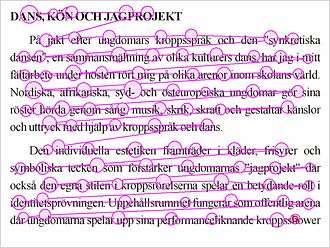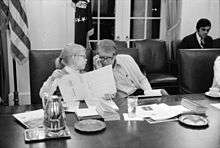Speed reading
Speed reading is any of several techniques used to improve one's ability to read quickly. Speed reading methods include chunking and minimizing subvocalization. The many available speed reading training programs include books, videos, software, and seminars. There is very little scientific evidence regarding speed reading.
| Part of a series on |
| Reading |
|---|
.jpg) |
| Learning to read |
| Scientific Theories & Models |
| Cognitive processes |
| Reading instruction |
| Reading rate |
| Readability |
| Reading differences & disabilities |
| Language |
| Literacy |

History
It was not until the late 1950s that a portable, reliable, and convenient device was developed as a tool for increasing reading speed. Evelyn Wood, a researcher and schoolteacher, was committed to understanding why some people were naturally faster at reading and tried to force herself to read very quickly. In 1958, while brushing off the pages of a book she had thrown down in despair, she discovered that the sweeping motion of her hand across the page caught the attention of her eyes, and helped them move more smoothly across the page. She then used the hand as a pacer. Wood first taught the method at the University of Utah, before launching it to the public as Evelyn Wood's Reading Dynamics in Washington, D.C. in 1959.[1]
Methods & Principles
Skimming and scanning
Skimming is a process of speed reading that involves visually searching the sentences of a page for clues to the main idea or when reading an essay, it can mean reading the beginning and ending for summary information, then optionally the first sentence of each paragraph to quickly determine whether to seek still more detail, as determined by the questions or purpose of the reading.[2][3][4][5][6] For some people, this comes naturally, but is usually acquired by practice. Skimming is usually seen more in adults than in children. It is conducted at a higher rate (700 words per minute and above) than normal reading for comprehension (around 200–230 wpm), and results in lower comprehension rates,[7] especially with information-rich reading material. Scanning is the process where one actively looks for information using a mind-map (organizing information in a visually hierarchical manner that showcases the interrelatedness of the information for better retrievability) formed from skimming. These techniques are used by meta-guiding your eyes. Scanning includes the main point as well as headings and important information.
Meta guiding
Meta guiding is the visual guiding of the eye using a finger or pointer, such as a pen, in order for the eye to move faster along the length of a passage of text. It involves drawing invisible shapes on a page of text in order to broaden the visual span for speed reading. For example, an audience of customers at a speed reading seminar will be instructed to use a finger or pen to make these shapes on a page and told that this will speed up their visual cortex, increase their visual span to take in the whole line, and even imprint the information into their subconscious for later retrieval. It has also been claimed to reduce subvocalization (saying words in your head rather than grasping the idea), thereby speeding up reading. Because this encourages the eye to skim over the text, it can reduce comprehension and memory, and lead to missing important details of the text. An emphasis on viewing each word, albeit briefly without regression (Regression is an unconscious process where the eyes go forward two or three “stops” and then go back.) is required for this method to be effective. E.g. S movement and Z movement
Speed reading is a skill honed through practice. Reading a text involves comprehension of the material. In speed reading practice this is done through multiple reading processes: preview, overview, read, review and recite; and by read and recall (recording through writing a short summary or a mental outline) exercises.[8] Another important method for better comprehension is the SQ3R process. These processes help an individual to retain most of the presented ideas from a reading material. A better focus in comprehension is attained through a better reading process with good understanding of the topic.
Types of reading
There are three types of reading
- Subvocalization: sounding out each word internally, as reading to yourself. This is the slowest form of reading.
- Auditory reading: hearing out the read words. This is a faster process.
- Visual reading: understanding the meaning of the word, rather than sounding or hearing. This is the fastest process.
Mental readers generally read at approximately 250 words per minute. Auditory readers read at approximately 450 words per minute. Visual readers read at approximately 700 words per minute. Proficient readers are able to read 280 - 310 wpm without compromising comprehension.[9]
Effect on comprehension
Skimming is mainly used for researching and getting an overall idea of a text, especially when time is limited. Duggan & Payne (2009) compared skimming with reading normally, given only enough time to read normally through half of a text. They found that the main points of the full text were better understood after skimming (which could view the full text) than after normal reading (which only read half the text). There was no difference between the groups in their understanding of less important information from the text.[10] Skimming or skipping over text can also aid in comprehension when layered reading, a process of strategic rereading, is employed.[11] Further findings suggest that trained speed readers have a slight advantage in both comprehension and speed to untrained skimmers. It is thus suggested by experts that speed-reading is most useful to those who need "to skim a large amount of material or need to improve their study skills" and less useful to those who read "highly technical material that requires careful study of each sentence" [12]
Software

Computer programs are available to help instruct speed reading students. Some programs present the data as a serial stream, since the brain handles text more efficiently by breaking it into such a stream before parsing and interpreting it. The 2000 National Reading Panel (NRP) report (p. 3-1) seems to support such a mechanism.
To increase speed, some older programs required readers to view the center of the screen while the lines of text around it grew longer. They also presented several objects (instead of text) moving line by line or bouncing around the screen; users had to follow the object(s) with only their eyes. A number of researchers criticize using objects instead of words as an effective training method, claiming that the only way to read faster is to read actual text. Many of the newer speed reading programs use built-in text, and they primarily guide users through the lines of an on-screen book at defined speeds. Often the text is highlighted to indicate where users should focus their eyes; they are not expected to read by pronouncing the words, but instead to read by viewing the words as complete images. The exercises are also intended to train readers to eliminate subvocalization, though it has not been proven that this will increase reading speed.
Controversies in speed reading
Common controversies in speed reading are between its intent and nature with traditional concepts like comprehension vs speed; reading vs skimming; popular psychology vs evidence-based psychology. Much of the controversy is raised over these points. This is mainly because a reading comprehension level of 50% is deemed unusable by some educationalists (Carver 1992). Speed reading advocates claim that it is a great success and even state that it is a demonstration of good comprehension for many purposes (Buzan 2000). The trade-off between "speed" and comprehension must be analyzed with respect to the type of reading that is being done, the risks associated with mis-understanding due to low comprehension, and the benefits associated with getting through the material quickly and gaining information at the actual rate is to be obtained. Mark Seidenberg considers claims like 25,000 words per minute "cannot be true given basic facts about eyes and texts" and comments that "people are as likely to read thousands of words per minute as they are to run faster than the speed of light".[13]

Similarly, in evaluating a claim that a similar reading strategy known as PhotoReading could increase reading rates to 25,000 words per minute, McNamara published a preliminary analysis funded by NASA to evaluate whether this strategy could improve reading speed, comprehension, and information gathering efficiency. When identical versions of five reading samples and accompanying reading comprehension tests were administered to a trainee and an expert in this reading strategy, there was no advantage in overall reading time or comprehension. This strategy may also cause overestimation of one's knowledge, as demonstrated by the following case in McNamara's preliminary analysis, showing evidence of the Dunning-Kruger effect:[14]
- The final task given to the PhotoReading expert was to read the three chapters from the textbook on Physiology in order to take an exam from a course that used that textbook. The question was simply: Would she pass the exam? The expert took 73 minutes to PhotoRead and read the three chapters of the textbook required for the test (i.e., 361 words per minute). She PhotoRead for 9 minutes the night before taking the test. The following morning, she read the text using various rapid reading and activation techniques. She then answered the questions. She completed the 6 true/false and 30 multiple choice questions, but did not attempt to answer the fill-in-the-blank or short-answer questions. Hence, comprehension performance on the conceptual questions was 0 percent. She answered 2 of 7 multiple-choice prior knowledge questions correctly (29%). Of the text relevant questions, she answered 4 of 6 true/false questions correctly (67%), and 8 of 23 multiple-choice question correctly (35%). This performance is extremely low and only slightly above chance level performance for these types of questions (i.e., 50% and 25%, respectively). In sum, she did not pass the exam.
- It is important to note that after PhotoReading the text (but before taking the test), she rated her understanding of the material as 4.5 on a 5-point scale (5 representing a good understanding). Moreover, she estimated that she would remember approximately 68 percent of the material for the test, with a grade of C+. This high level of confidence in terms of her text comprehension would have remained unshattered had she not then taken the test - after which she rated her comprehension much lower (i.e., 2)

In a 2016 article[15] published in the journal of 'Psychological Science in the Public Interest', the authors conclude there is no 'magic bullet' for reading more quickly while maintaining comprehension other than to practice reading and to become a more skilled language user (e.g. through increased vocabulary). The authors proceed with debunking common speed reading techniques such as eliminating sub-vocalization, reading more than one word at a time a.k.a. grouping, using RSVP (Rapid Serial Visual Presentation), increasing peripheral vision, alternating colors for each line of text.
U.S. President John F. Kennedy was a proponent of speed reading,[16] encouraging his staff to take lessons, and he suggested in an interview that he had a reading speed of 1,200 words per minute.[17] U.S. President Jimmy Carter, and his wife Rosalynn, were both avid readers and enrolled in a speed-reading course at the White House,[18] along with several staff members.
Ronald Carver, a professor of education research and psychology, claims that the fastest college graduate readers can read only about 600 words per minute, at most twice as fast as their slowest counterparts, and suggests that Kennedy's claimed reading speed was more a measure of how fast he could skim a piece of text.[19] Other critics have suggested that speed reading is actually skimming, not reading.[20]
The World Championship Speed Reading Competition stresses reading comprehension as critical. The top contestants typically read around 1,000 to 2,000 words per minute with approximately 50% comprehension or above. The six time world champion Anne Jones is recorded for 4200wpm with previous exposure to the material and 67% comprehension. The recorded number of words the eye can see in single fixation is three words.[21]
"Speed Reading World Record" claims have been controversial. Howard Stephen Berg from the United States has claimed to be the Guinness World Record holder for fast reading with a speed of 25,000 words per minute,[22] and Maria Teresa Calderon from the Philippines claims to have earned the Guinness World Record for World's Fastest Reader at 80,000 words per minute reading speed and 100% comprehension.[23] Critics point out that it is possible to beat some speed reading world records by reading a pre-read or pre-memorized text, flipping the pages as fast as possible without reading it. The Guinness Speed Reading World Record Standards are not known and they have terminated adding speed readers to its honor list. In 2015, Memoriad, the World Mental Sports Federation, set the rules for "Speed Reading World Record Standards" in order to prevent unclear claims.[24][25]
See also
- Incremental reading − reading method aimed at long-term memorization
- Learning styles
- Pareto principle
- Rapid serial visual presentation
- Slow reading − intentional reduction in the speed of reading
- SQ3R − reading comprehension method
- Vision span
- Visual fixation
- Words per minute
References
- Frank, Stanley D (1994). The Evelyn Wood Seven-Day Speed Reading and Learning Program. Cambridge University Press. p. 40. ISBN 9781566194020.
- "Study Skills - Effective reading strategies". Retrieved 11 August 2017.
- "How to read an academic article - part 7". Retrieved 11 August 2017.
- "How to read an academic article". Retrieved 11 August 2017.
- "How to Read a Paper" (PDF). Retrieved 11 August 2017.
- "Paragraphs and Topic Sentences". Retrieved 11 August 2017.
- Just, Marcel Adam. "Speedreading". Allyn and Bacon. Retrieved 15 May 2016.
- "Method to Improve Reading Speed".
- "Speed Reading". The University of Chicago Student Health and Counseling Services. Archived from the original on 7 March 2018. Retrieved 30 December 2017.
- Duggan, GB.; Payne, SJ. (September 2009). "Text skimming: the process and effectiveness of foraging through text under time pressure" (PDF). J Exp Psychol Appl. 15 (3): 228–42. doi:10.1037/a0016995. PMID 19751073.
- Doug Lemov; Colleen Driggs; Erica Woolway (29 February 2016). Reading Reconsidered: A Practical Guide to Rigorous Literacy Instruction. John Wiley & Sons. pp. 63–. ISBN 978-1-119-10424-7.
- Vanderlinde, William (2018). "Speed Reading: Fact or Fiction?". Skeptical Inquirer. 42 (4): 47–49.
- Mark Seidenberg (3 January 2017). Language at the Speed of Sight: How We Read, Why So Many Can't, and What Can Be Done About It. Basic Books. ISBN 978-0-465-08065-6.
- McNamara, Danielle S (30 September 1999). "Preliminary Analysis of PhotoReading" (PDF). NASA NTRS Server. Retrieved 13 December 2018.
- Rayner, Keith; Schotter, Elizabeth R.; Masson, Michael E. J.; Potter, Mary C.; Treiman, Rebecca (14 January 2016). "So Much to Read, So Little Time". Psychological Science in the Public Interest. 17 (1): 4–34. doi:10.1177/1529100615623267. ISSN 1529-1006. PMID 26769745.
- "John F. Kennedy on Leadership".
- "JFK, Speed-Reader - Slate Magazine". February 2000. Archived from the original on 10 February 2013. Retrieved 13 March 2019.
- "American Experience".
- Noah, Timothy (18 February 2000). "The 1,000-Word Dash". Slate.
- "The Skeptic's Dictionary".
- Bremer, Rod (September 2011). The Manual: A Guide to the Ultimate Study Method (2 ed.). Fons Sapientiae Publishing. ISBN 978-0-9934964-0-0.
- "Howard Berg "World's Fastest Reader" on Good Day Tampa Bay Fox 13".
- "World's fastest reader (80,000 words per minute)".
- "SPEED READING WORLD RECORD STANDARDS - Memoriad".
- "Speed Reading World Record Standards".
Footnotes
- Just, M.A. & Carpenter, P.A. (1987) The Psychology of Reading and Language Comprehension. Boston: Allyn & Bacon.
- Buzan, Tony (2000) The Speed Reading Book. BBC Ltd
- Carver, R.P. (1990) Reading Rate: A Comprehensive Review of Research and Theory.
- Carver, R. P. (1992). "Reading rate: Theory, research and practical implications". Journal of Reading, 36, 84-95.
- Cunningham, A. E., Stanovich, K. E., & Wilson, M. R. (1990). "Cognitive variation in adult college students differing in reading ability". In T. H. Carr & B. A. Levy (Eds.), Reading and its development: Component skills approaches (pp. 129–159). New York: Academic Press.
- Educational Research Institute of America (2006). A Review of the Research on the Instructional Effectiveness of AceReader. Report No. 258.
- Harris, Albert J.; Sipay, Edward R. (1990) How to Increase Reading Ability. Longman
- FTC Report (1998)
- Homa, D (1983) "An assessment of two “extraordinary” speed-readers". Bulletin of the Psychonomic Society, 21(2), 123-126.
- McBride, Vearl G. (1973). Damn the School System—Full Speed Ahead! Exposition Press.
- National Reading Panel (2000). p. 3-1.
- Nell, V. (1988). "The psychology of reading for pleasure. Needs and gratifications". Reading Research Quarterly, 23(1), 6-50
- Perfetti (1995) Reading Ability. New York: Oxford University Press
- Schmitz, Wolfgang (2013) Schneller lesen - besser verstehen [Reading faster - understanding better, German], Rowohlt, 8th edition
- Scheele, Paul R (1996) The Photoreading Whole Mind System.
- Stancliffe, George D (2003) Speed Reading 4 Kids.
- Evelyn Nielsen Wood; Marjorie Wescott Barrows (1958). Reading Skills. Holt, Rinehart and Winston.
- Zach Davis (2009) PoweReading. Informationswelle nutzen, Zeit sparen, Effektivität steigern (German). Peoplebuilding Verlag.
- "Reading: Skimming and scanning". bbc.co.uk. BBC. Retrieved 13 August 2019.
External links
| Wikibooks has a book on the topic of: Speed Reading |
- How To Read 3x Faster: Some Advice from Readlax Readlax blog, Medium
- Tim Ferriss on Speed Reading, The Huffington Post